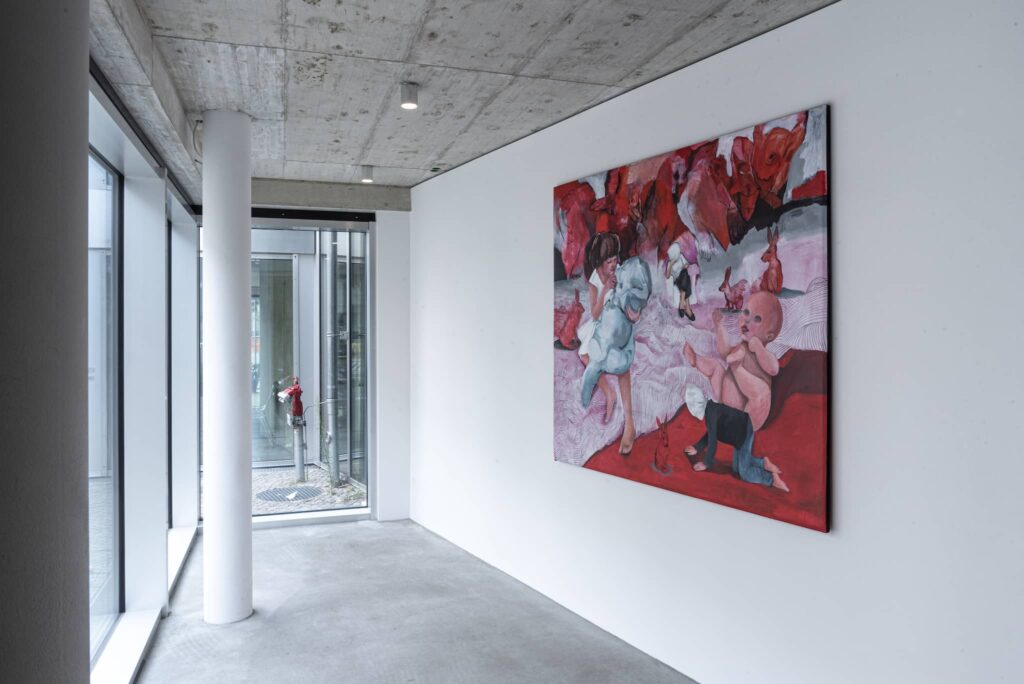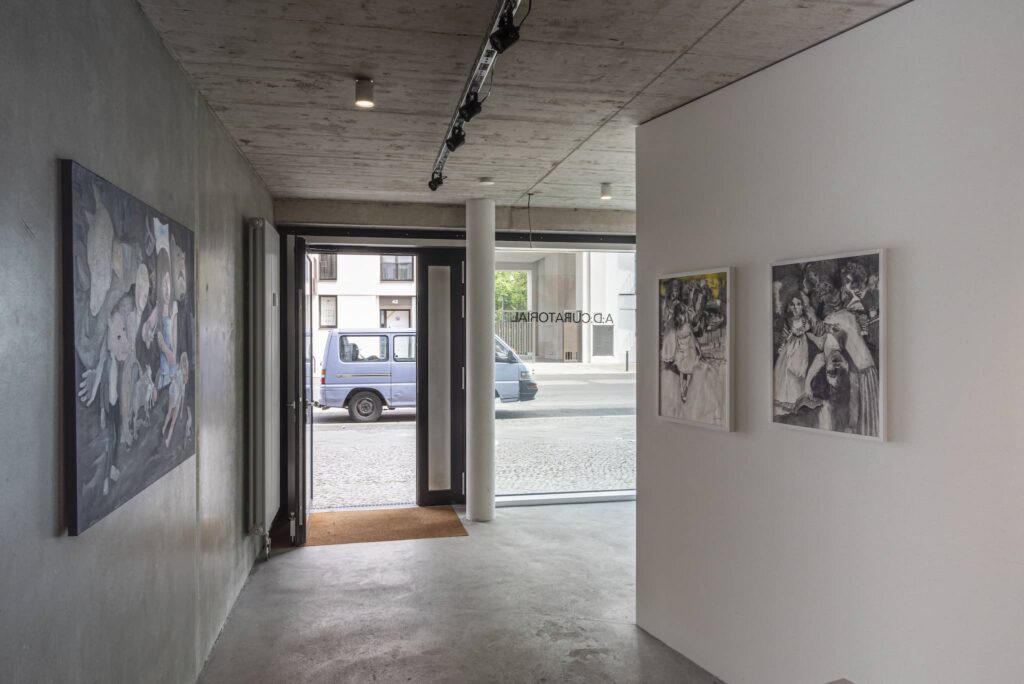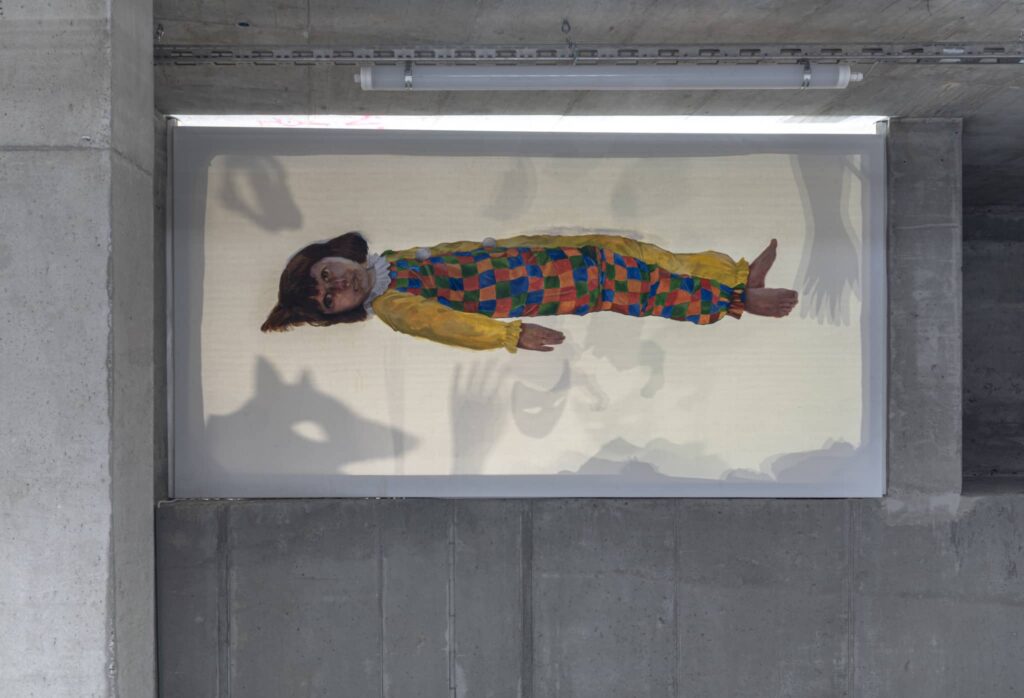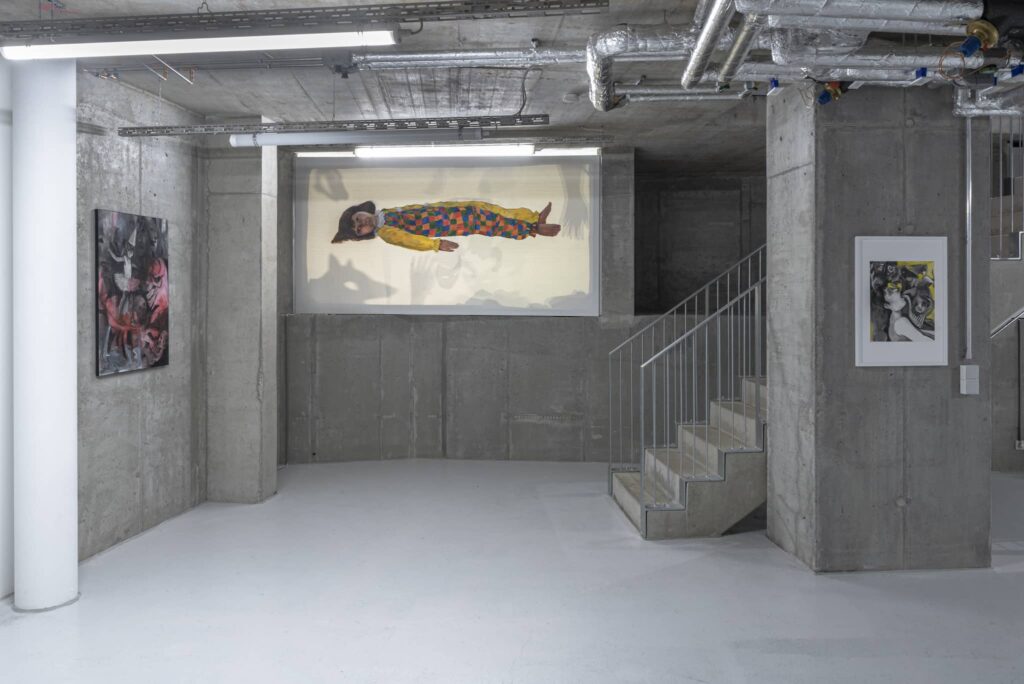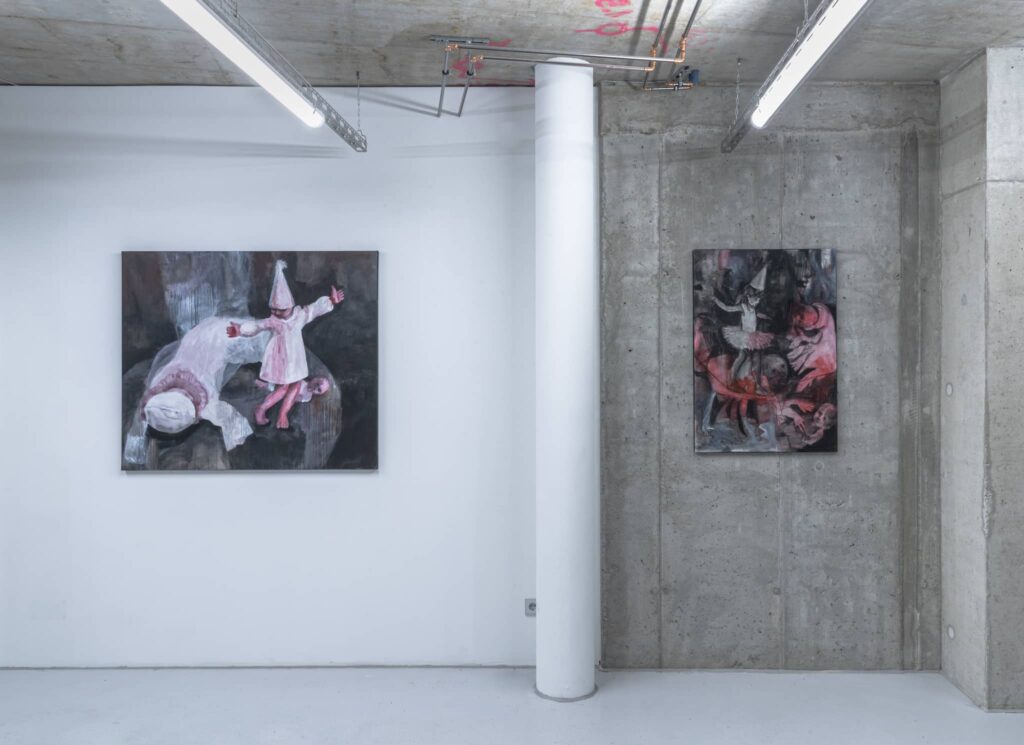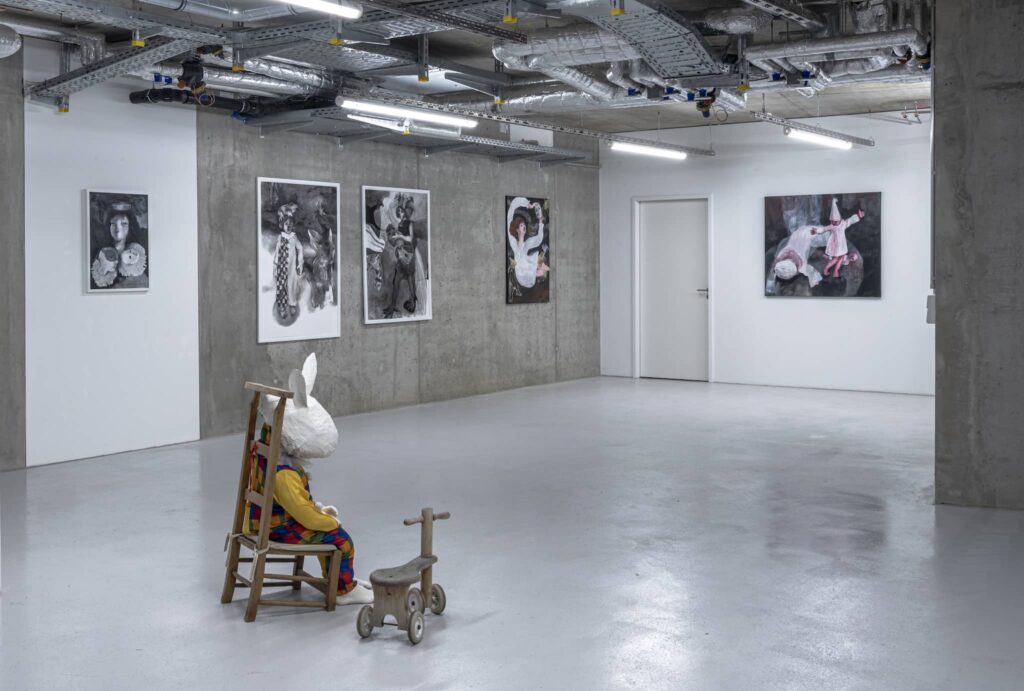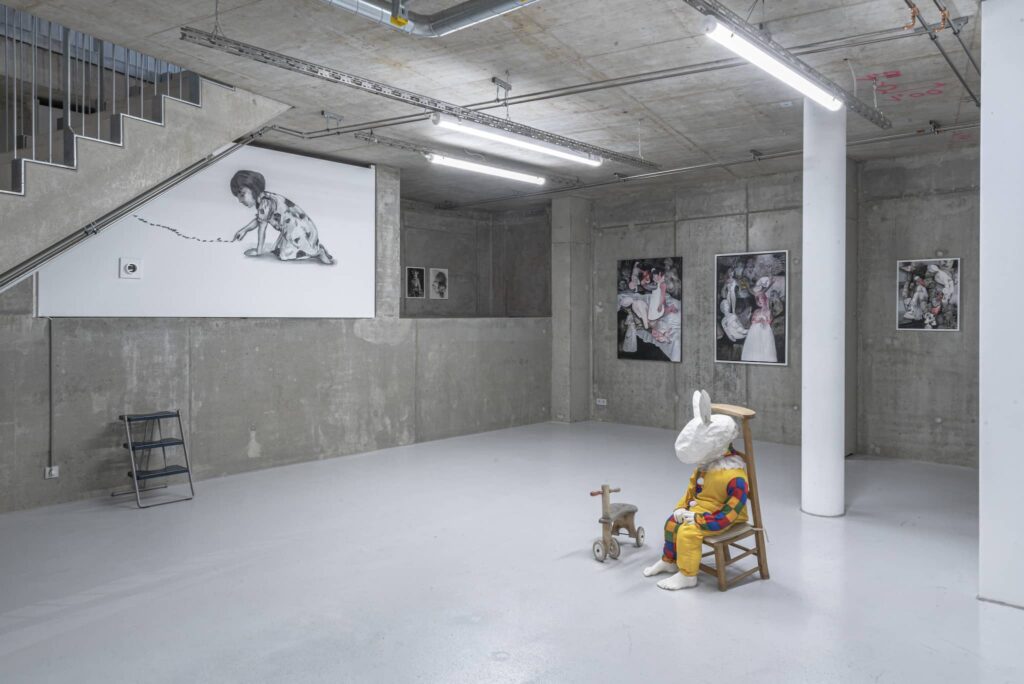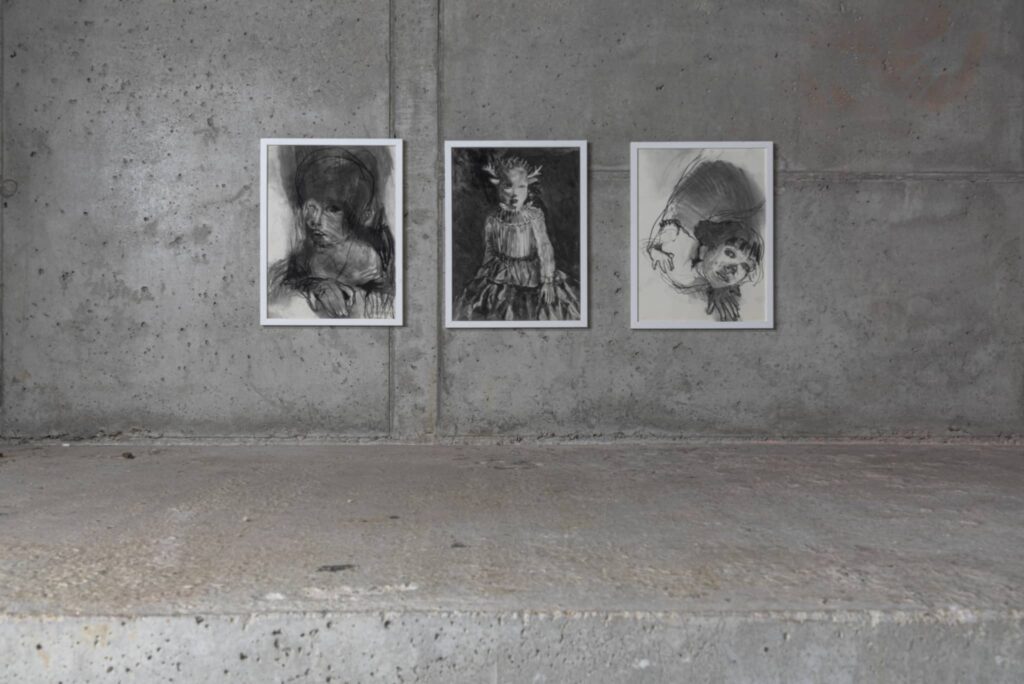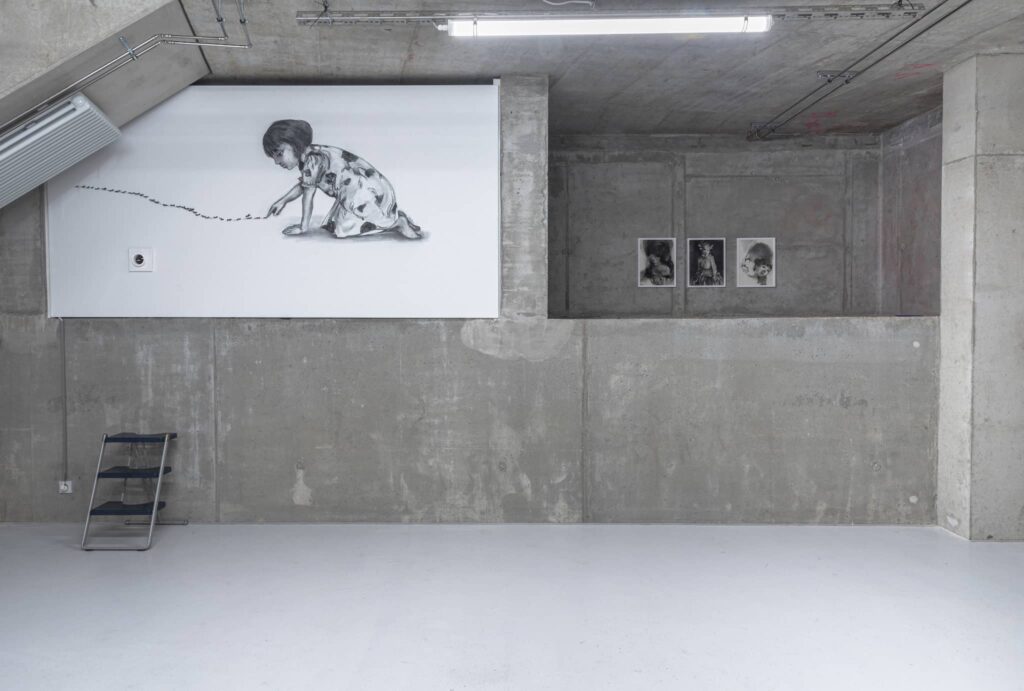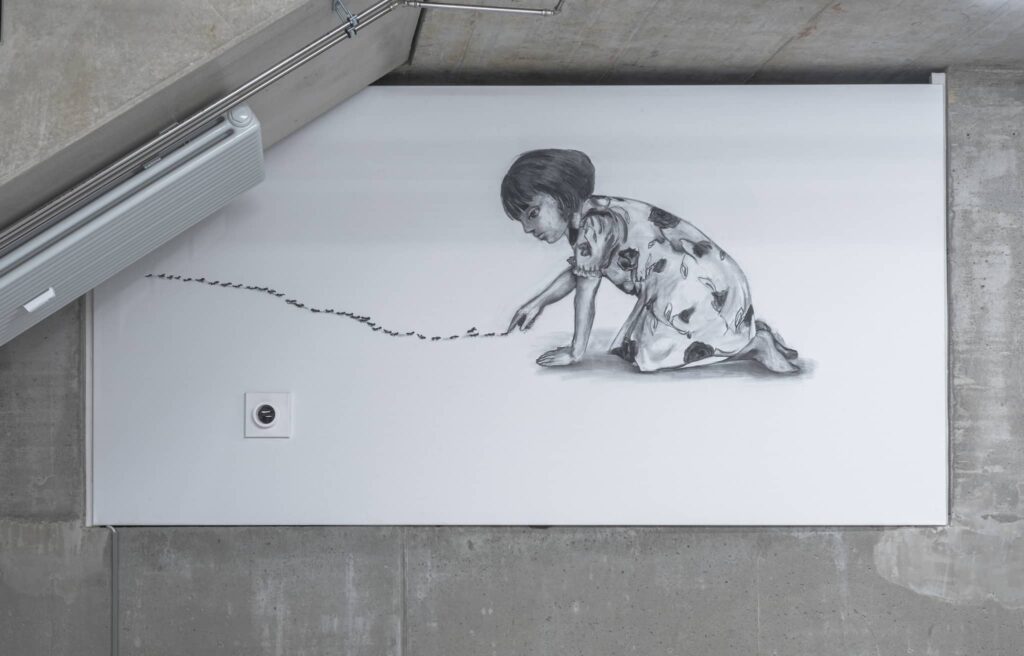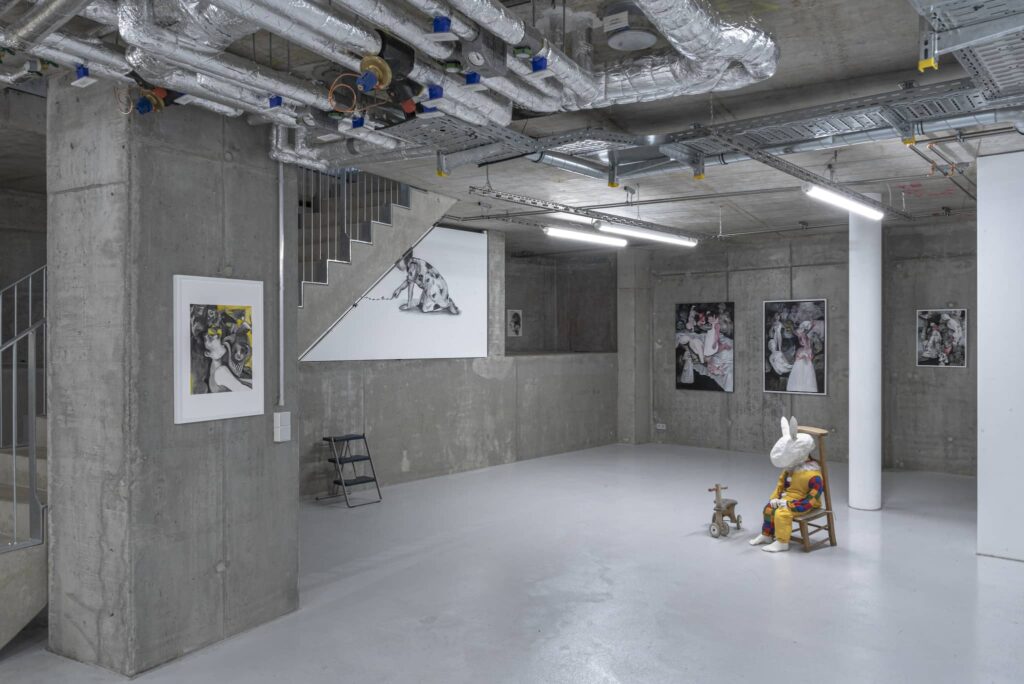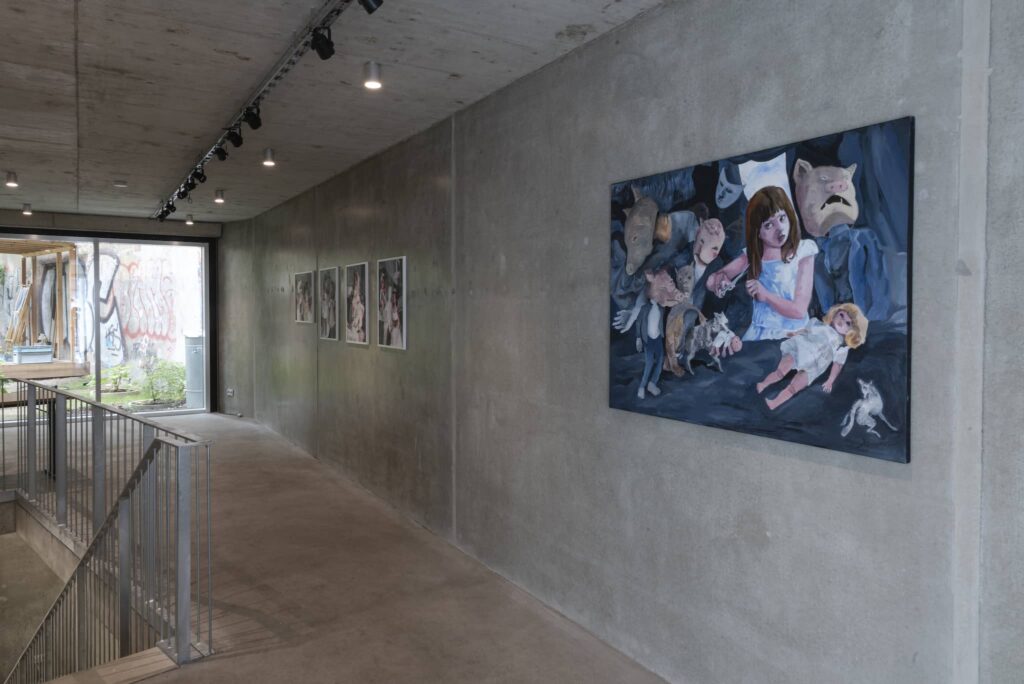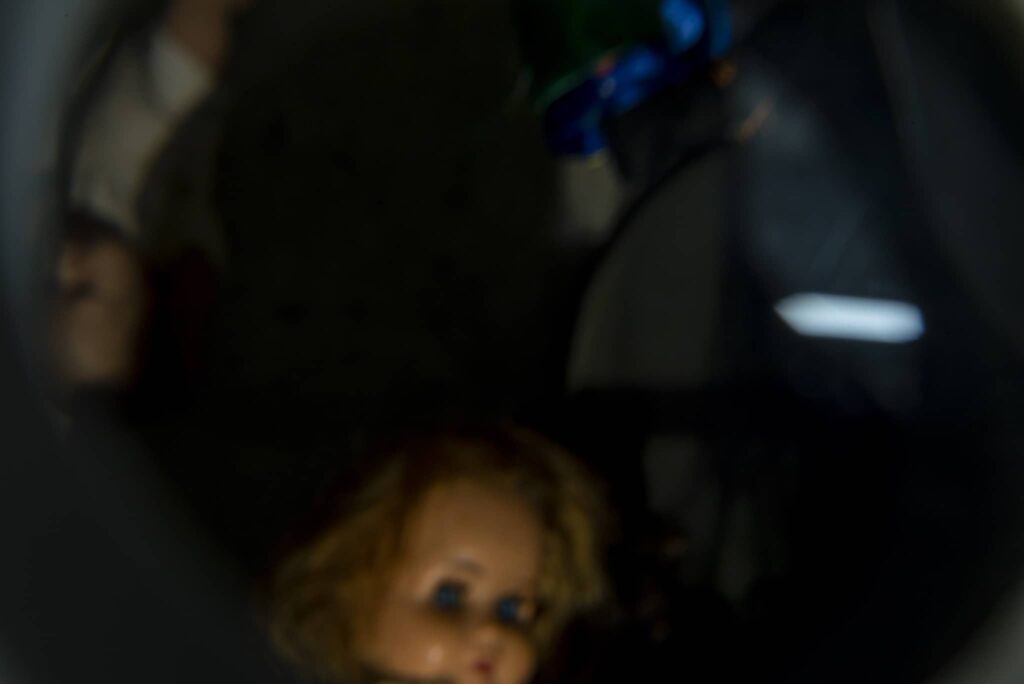Exhibition Note.
A:D: Curatorial hosted Zahra Zeinali’s exhibition au-delà from July 15th to August 30th. The exhibition brings together a series of Zahra Zeinali’s paintings and installations from the last three years for her first solo show in Berlin, Germany.
In au-delà, Zahra Zeinali uses the prism of her experiences as an Iranian immigrant to examine themes of exile, displacement, and trauma. She employs this to explore the sensations and memories of loneliness and vulnerability, expressing the agony and concussion of being uprooted and forced to navigate an unknown backdrop. In the following text, we extend an invitation to read about four series featured in the exhibition: Perdu (2020), REM (2021), Elle ferma les yeux (2021), and Adaptation (2021-2022).
The Perdu series (2020) marked a significant turning point in Zahra Zeinali’s life. After spending seven years in Paris, she returned to Iran with a strong desire to rediscover a sense of belonging that had eluded her in her adopted country. However, upon her return, she found that both she and her homeland had undergone significant changes, leading to a profound disconnection between them. This resulted in a feeling of rootlessness, characterized by loneliness, emptiness, and uncertainty.
During this period of self-exploration, Zeinali focused on questions of identity, reflecting on her past and present self, while also delving into her inner world with great curiosity. This introspective journey revealed a hidden realm of depth and complexity that, unknown to her, had silently accompanied her throughout her life. In her paintings from this phase, the use of color was notably limited to white, red, and black hues. She believed that vibrant colors represented the external world, whereas the inner world required a more muted representation.
The narrative of her work revolved around a central figure, a young girl, surrounded by personal artifacts such as vintage dolls from Parisian second-hand stores, self-made masks, fabrics, and theater-inspired puppets. These elements were arranged in front of a dimly lit backdrop, evoking a theatrical stage where the unfolding drama takes place in an obscure black box, hidden from the audience’s full view. This symbolic approach conveyed the idea that human perception provides only a partial glimpse of truth, much like witnessing only a fraction of events backstage. Zeinali assumed the role of a theatrical director, skillfully orchestrating these representations on the stage to manifest various states of mind and inner emotions – a manifestation rooted in a cognitive perspective.
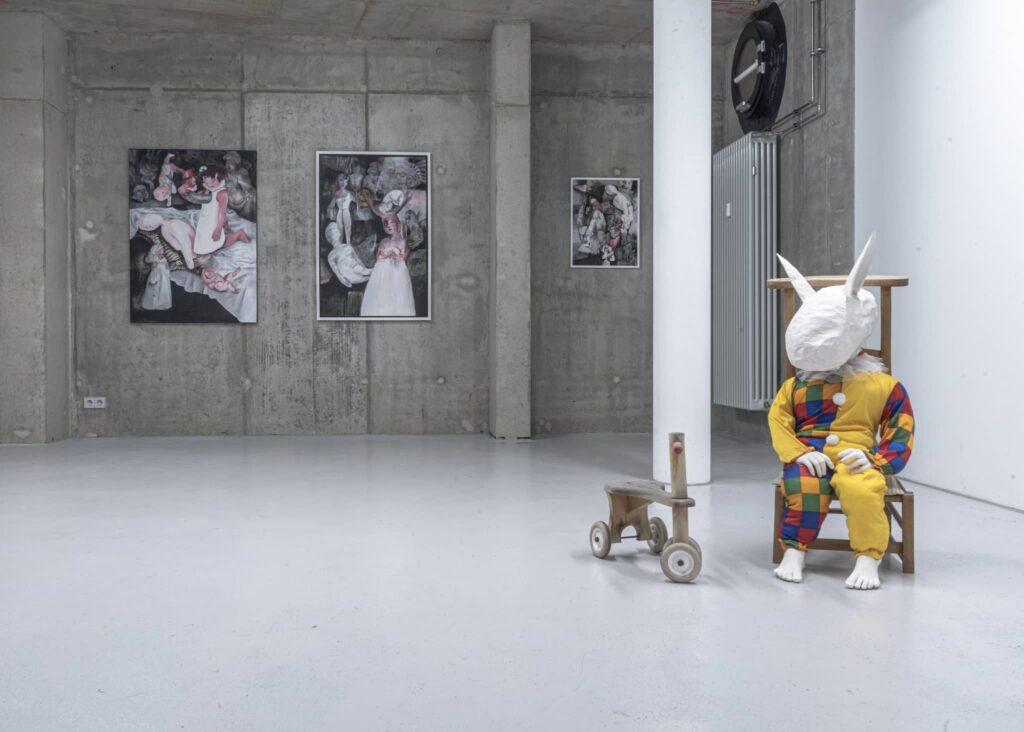
The series REM (2021) and Elle ferma les yeux (2021-2022) continued to focus on the inner world she had discovered – a realm characterized by contradictions, fears, and dreams, akin to the enigmatic nature of dreams or nightmares. Zeinali translated this peculiar inner world onto canvas, naming the collection “PARADOX SLEEP (REM)”. This denotes the state between deep slumber and wakefulness, where reality and imagination converge, echoing the essence of her paintings.
The paintings in these series featured doll-like figures often shrouded in shadows, resembling theatrical scenes. The overall outlook towards the world and reality was somewhat pessimistic and bitter. The backgrounds of the paintings avoided depicting specific locations or spaces, emphasizing the emergence of the characters from darkness, like figures on a theater stage. Zeinali’s choice of colors remained limited, with a focus on using acrylic as her medium, resulting in expressive and emotionally intense paintings from subjective perspectives.
The series Elle ferma les yeux (2021) was influenced by a deeply unfortunate event in her life toward the end of 2021, the impact of which resounded until late 2022. During this period, new colors, such as blue and yellow, were introduced, imbued with symbolic meanings. As a result, the artworks gradually incorporated surrealistic procedure, prompting contemplation on death and the intricacies of the human subconscious. This phase revealed Zahra Zeinali’s newfound sense of independence in her expression.
The essence of each entity’s existence, as perceived by the artist, holds a bitter and disconcerting truth. As she delved deeper into exploration, more unsettling facets of this truth surfaced. This newfound understanding of the world significantly influenced the artist’s actions and mindset, leading her to question the very meaning and purpose of life.She grapples with the daunting task of navigating life in a peculiar and fearsome world. This internal struggle gave rise to the Adaptation (2021-2022) series. In these artworks, subtle shifts in the main characters’ dispositions are portrayed, reflecting a sense of acceptance of one’s circumstances and a confrontation with enigmatic and unsettling realities. This phase is deemed crucial and challenging, as it supports reconciliation of the artist’s relationship with both herself and the world.
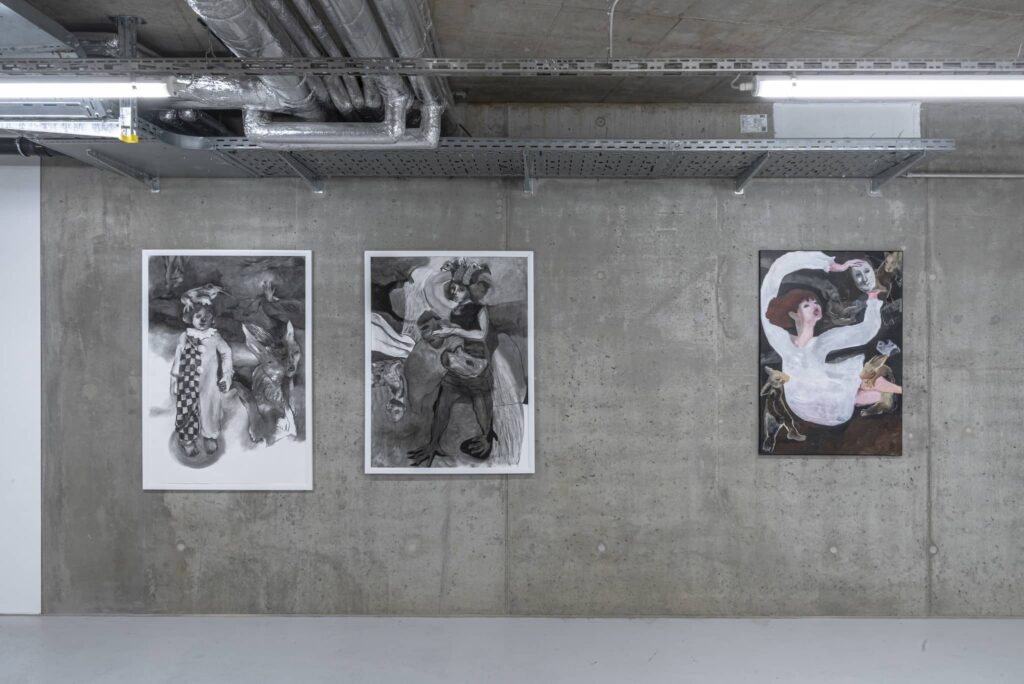
Technically, Zahra Zenali embarks on a journey into unknown territory by using relatively large canvases for the first time. The characters in the artworks move from unfamiliar spaces to more familiar places that remind us of untouched nature. The artworks show the coexistence of unique entities and characters, blending together harmoniously in a single frame, without any resistance or conflict. Her subsequent works, while not explicitly labeled as part of the Adaptation series, continue to be strongly influenced by her explorations during this period.
_ In conversation with Zahra Zeinali
Zahra Zeinali (b. 1975) completed her bachelor’s degree in painting from the Islamic Azad University of Tehran and worked as an art instructor for fifteen years. She developed an interest in photography and studied analog photography at the House of Iranian Photographers. In 2012, Zahra relocated to Paris to continue her artistic journey as a painter. Later, in 2022, she completed her studies at the EFET Photographie École. This milestone prompted her to explore merging the two techniques in her recent works. Additionally, she commenced her role as an art teacher for children and young students at Le Cercle des Arts in 2022, allowing her to tap into the realm of childhood inspiration. Zeinali has participated in several groups and solo exhibitions, including the recent Le Pays des Merveilles, Le Monde Invisible at Galerie Claire Corcia, and Alerte Rouge at Galerie Linda Farrell, Femme Vie Liberté at Galerie Sahar K. Boluki, Artcité à Fontenay, Comparaison au Grand Palais Éphémère, and Figuration Critique à Salon de Dessin Paris, among others.
A:D: Curatorial runs by two young curators from the USA and Ukraine, Christy Woody and Maria Isserlis, the mission of the space is to focus on creating a platform for today’s innovative artists to be heard in a non-commercial environment. Inviting artists from around the world, we aim to keep the cultural bridges open for collaborations, exchanges, and the development of new works. Through young, vibrant voices in the current art and music scene, we would like to thoughtfully reflect on the current political, social and environmental climate and progress with a successful example of cooperation in the field of art and culture in Berlin.
